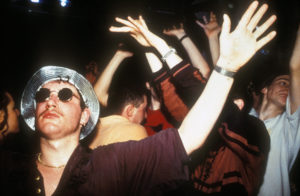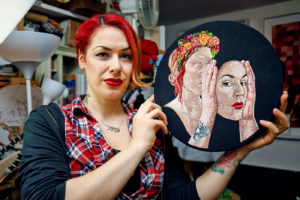I was visiting an exhibition last week when I came across a painting I had handled, several years back. I knew it well from my time working in the art world, so it was a bit like bumping into an old friend; you know the one — intense and brilliant and tiring. You see them sparingly, and when you do so it’s usually with the feeling that it’s come far too soon.
As an art lover, being desensitised to a painting that once held you in its thrall can feel like a minor bereavement. But after years spent looking after works like this one, in airport lounges and cold warehouse storerooms, this detachment often becomes second nature; you develop a necessary blindness to the qualities of the work, and at the same time a hypervigilance for the cosmetic and technical detail others might not see.
This skewed perspective forever alters your gallery-going experience. Forget the brushwork — is the wall spotless? Is the label perfectly straight? Is the centre of the artwork 155cm from the floor? Are the correct fixings being used? I couldn’t help myself. As the well-dressed crowd thinned off, and with one eye on the guard, I pressed my cheek to the wall and peeked around the back of the frame of the painting; spring lock fixings — perfect.
Over the past two decades, I have worked in a variety of jobs which brought me into contact with very valuable works of art. With budgets cut to the bone and deadlines moving by the hour, the establishment art world is — behind the façade — surprisingly low on glamour. Job titles are fluid and often bear no resemblance to the duties performed; one minute you might be touching up a million-pound picture, the next scraping half-eaten canapes off the gallery floor.
Of all the people I worked with, the ones who carry the heaviest load, literally and figuratively, are not the polished curators or gallery assistants, but the art handlers. Far from the press images of men in cotton gloves and Persiled shirts, the day-to-day world of art handling is one of bulging necks, Status Quo ponytails, Rustlers Burgers for breakfast; gallons of sweat and total aesthetic desensitisation.
Art handlers deal with everything: cars, swords, books, clocks, Picassos, ancient fossils, the blouse Marc Bolan wore on Top of the Pops, the horrendous sculpture that just got craned onto the mud outside your local town hall. And working at ground level, they have a pretty decent insight into the art world’s shortcomings, not to mention a wealth of trivia about the items they handle.
Who knew that every glass drop on a crystal chandelier has to be individually packed and accounted for? Or that Tudor oak beds were made for self-assembly, with helpful matching emblems carved at each joint? Who could have guessed that compressed air is the tool of choice for cleaning dust from the arse-cracks of marble nymphs? And in a world of very old, and very heavy stuff, there are horror stories, too.
Decaying country houses are, of course, the source of so much valuable property, but when an owner decides to flog the family silver, someone has to go in and get it. Legends abound: rotting food, dead pets, dead people; removing desiccated surgical gloves and rigid tubes of Anusol from Georgian bedside tables; choking down the dandruff of some dead Viscount as his rug is shoulder-carried onto a van for the first time in its 300-year existence.
Filthy jobs coupled with meticulous processes, brain-melting repetition and seriously heavy lifting can soon lead to burnout. Being at the sharp end of the movement of art, and having responsibility for displaying works and decorating gallery spaces, it is the art handlers who often bear the brunt of the shifting aesthetic whims and crazy deadlines imposed by clients sprawled on far-off sun-loungers. But there are bigger issues than burnout and dissatisfaction among what is a relatively small sector of workers.
Accessibility, equitable pay, diversity, sustainability; these are just a few of the areas in which the art world lags behind. On websites and in catalogues, there are pledges and logos galore, but behind the scenes progress is slow. The art world emits 77 million tonnes of CO2 annually — more than Austria — with the annual programme of international art fairs accounting for much of it. But behind-the-scenes artworks are also flying solo around the globe, constantly, in a kind of try before you buy. A sculpture might be delivered to a castle or villa and installed there for what amounts to a 15-minute “vibe check”: Is the new piece initiating a dialogue with other works in the collection? Does it make the peach tones pop on the collectors new chaise longue? If not, it flies straight back home to await its next summons.
In the art and antiques world, more than possibly any other sector, presentation, exclusivity and mystique is key, and accessibility comes very far down the list of concerns. Nepotism means positions in the art world are often filled by underqualified people from privileged backgrounds. While of course well-meaning, and in many cases determined to work hard, they have often been insulated from their failures by family connections, and do not have the robustness or the range of practical life experience that working your way up in a job, and sometimes stumbling, brings.
How motivated and alert to real-world issues can you expect your organisation to be when you employ people who talk about their annual salary as a dining allowance? Or who have never used a hoover? Imagine it’s all hands-on-deck before a big exhibition and you pass one of the many smiling Henry hoovers to a new gallery assistant, only to watch them stand in the midst of a war zone of cleaning and painting, gripping the tube attachment, staring at it with the kind of vacant reverence a man in the street might reserve for a semi-automatic weapon.
Nepotism is particularly harmful to an industry which already lags painfully behind others in so many aspects of modernising itself, but the truth is, “nepotism babies” — as Hollywood has labelled them — fit a little too cosily in the establishment art scene. They offer just another layer of unreality in a world which is already bizarrely unfocused; where the walls are cleaned with pencil erasers, the ceilings are hoovered as thoroughly as the floors, and the flowers get more water than the security guards.
The atmosphere created by this rigorous attention to detail — often laboured over by low-paid workers such as the art handlers, as well as tradesmen such as carpenters and decorators — is entirely rarefied and proudly intimidating; many commercial galleries will claim unfailingly that they are “open to all”, but visitor numbers rarely bear that out. Now, as large-scale sensory installations and one-off immersive experiences draw younger crowds to art for the first time, traditional galleries are increasingly looking for ways to invigorate a century-old business model built on plain white walls and warm white wine, and overly reliant on an ageing client base.
Increasingly, they are up against a growing crowd of passionate and diverse curators who are democratising the gallery-going experience through social media and a do-it-yourself ethos. Subversive, attention-grabbing art and rugged warehouse exhibition spaces are nothing new, but what is novel is the energy and thoughtfulness of these up-and-coming facilitators, who shy away from explicit commercialisation by focussing on creativity and collaboration.
Often staged in public venues and disused commercial premises, these types of exhibition offer a welcome stimulus at a time when urban areas look more desolate than ever, and people feel increasingly disconnected from their surroundings. Big galleries are wise to the growing appeal of this type of transient and evolving installation, but copying an organic movement is not easy, and a lot of institutions already look like the embarrassing dad in ripped jeans as they announce copycat collaborations and pop-up shows that are as carefully staged as any flawless blockbuster exhibition.
Discovering something unexpected, by someone unexpected, in a place you never thought you might find it, feels like breathing clear air when compared to the audio-guided trudge, or the empty white cube that we have dutifully turned up to for so long. For myself and many of my colleagues, the thrill of handling very valuable art wore off quickly; seeing under the bonnet of the established gallery and museum world killed any enthusiasm we might have had for its commodification. But the experience of making new discoveries by unknown artists has caused me to re-evaluate my relationship to art in the first place. More than anything, these experiences are about the art itself, with no room for the carefully constructed illusions that myself and my colleagues once worked so hard to maintain.
Disclaimer
Some of the posts we share are controversial and we do not necessarily agree with them in the whole extend. Sometimes we agree with the content or part of it but we do not agree with the narration or language. Nevertheless we find them somehow interesting, valuable and/or informative or we share them, because we strongly believe in freedom of speech, free press and journalism. We strongly encourage you to have a critical approach to all the content, do your own research and analysis to build your own opinion.
We would be glad to have your feedback.
Source: UnHerd Read the original article here: https://unherd.com/





